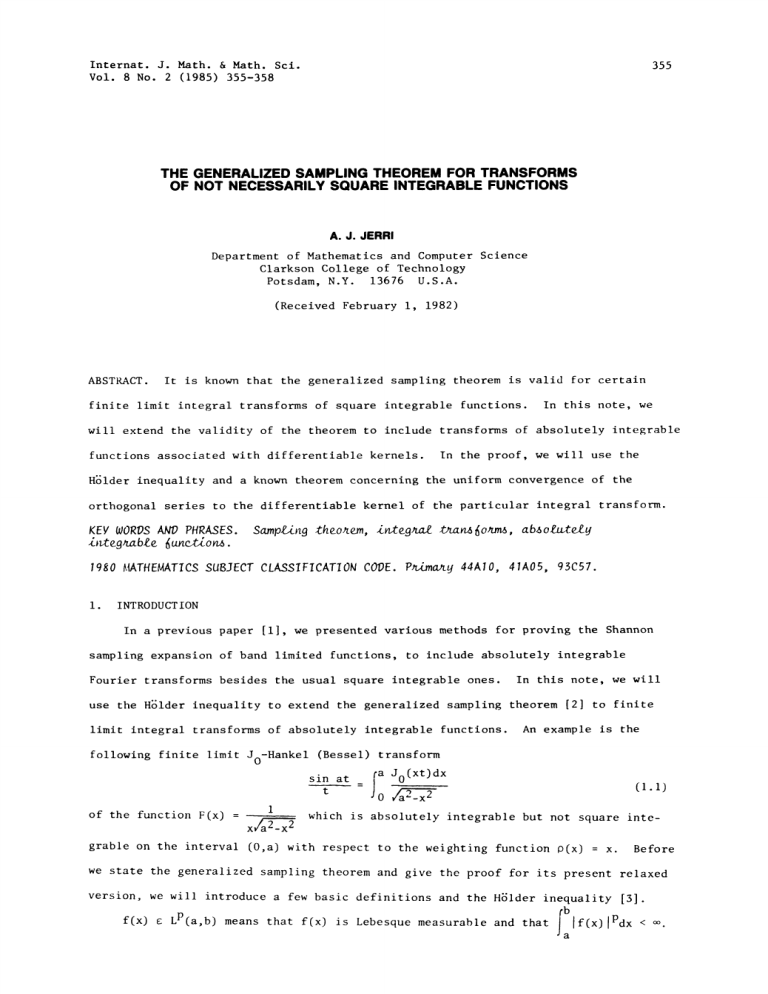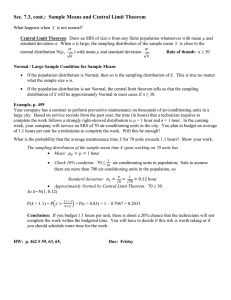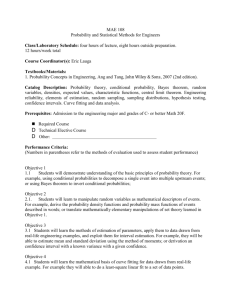Document 10484134
advertisement

Internat. J. Math. & Math. Sci.
Vol. 8 No. 2 (1985) 355-358
355
THE GENERALIZED SAMPLING THEOREM FOR TRANSFORMS
OF NOT NECESSARILY SQUARE INTEGRABLE FUNCTIONS
A. J. JERRI
Department of Mathematics and Computer Science
Clarkson College of Technology
Potsdam, N.Y. 13676 U.S.A.
(Received February i, 1982)
ABSTRACT.
It is known that the generalized sampling theorem is valid for certain
finite limit integral transforms of square integrable functions.
In this note, we
will extend the validity of the theorem to include transforms of absolutely integrable
functions associated with differentiable kernels.
Hider inequality and
In the proof, we will use the
a known theorem concerning the uniform convergence of the
orthogonal series to the differentiable kernel of the particular integral transform.
KEY WORDS AND PHRASES.
iegrable funons.
Sampling theorem, integral transforms, absolutely
1980 THEMATICS SUBJECT CLASSIFICATION CODE. Primary 44A10, 41A05, 93C57.
i.
INTRODUCT ION
In a previous paper [i], we presented various methods for proving the Shannon
sampling expansion of band limited functions, to include absolutely integrable
Fourier transforms besides the usual square integrable ones.
use the
HIder inequality
to extend the generalized sampling theorem
limit integral transforms of absolutely integrable functions.
following finite limit
Jo-Hankel
x/a2-x 2
[2]
to finite
An example is the
(Bessel) transform
sin at
t
of the function F(x)
In this note, we will
[a
Jo(Xt)dx
JO ai
(I.I)
which is absolutely integrable but not square inte-
grable on the interval (O,a) with respect to the weighting function p(x)
x.
Before
we state the generalized sampling theorem and give the proof for its present relaxed
version, we will introduce a few basic definitions and the HSlder inequality [3].
f(x) e
cP(a,b)
means that f(x) is Lebesque measurable and that
a
If(x) lPdx
A.J. JERRI
356
The norm
lfllp of
f is defined by
I[fl
If(x) [Pdx] p
[p
The following inclusion relation may prove valuable.
C c...
where C
iable.
k
ck c...ccO
cck+
(1.2)
a
L
For k > 0 and 0 < q < p <
q
Lp
L
(1.3)
stands for the set of functions which are k-times continuously different-
A sequence
SN(X
is said to converge in the mean of order p to f(x) if
rb
lim] [f-SN(X )[pdx
NooJ a
(1.4)
0.
For p=, this convergence is equivalent to uniform convergence in the sense of the
lfll
norm
HLDER
_<
where
p
I.
INEQUALITY"
_<
and
+
-
For a finite or infinite interval, let f e Lp and g e L p
1- then
I[fg[dx <_ [i[f[Pdx][I[g[P’dx]-r
2.
(1.5)
TIlE GENERALIZED SAMPLING TIIEOREM
The statment of the generalized sampling theorem is-
Let
be an interval.
Suppose that for each real t
f(t)
2
where g(x) e L (I), K(t,x)
L
2(I)
L2(I),
K(t,x)g(x)dx
and
{K(t n ,x)}
(2.1)
is a complete orthogonal set on
Then
f(t)
f(tn)Sn(t)
l
lim
(2.2)
where
Sn (t)
K(t,x) K(t n’ x)dx
K(t n,x)
Unless otherwise indicated, summations like
(2.2).
(2 .3)
2dx
Zc n will assume summation limits as in
Shannon’s sampling theorem represents a special case of this theorem corre-
sponding to K(t,x)
e
ixt
on the interval
[-a,a].
The origin and various extensions
and applications of the sampling theorems are discussed in detail
in a tutorial
review article by the author
[4] with nearly 250 references.
In this article, we
only hint at the possibility, among other remarks, of the
following extension.
Here we present the relaxed version of this generalized sampling theorem to
357
GENERALIZED SAMPLING THEOREM FOR TRANSFORMS
allow g(x) e
LP(a,b)
2
< p < 2 instead of g(x) e L (a,b) only, for all differ-
with
entiable kernels K(-,x).
THEOREM.
g(x) e
LP(a,b)
The above generalized sampling expansion (2.1)-(2.5) is valid for
< p < 2, for all differentiable kernels K(-,x).
where
The proof will rely mainly on using the HSlder inequality (1.5) instead of its
special case, the Schwarz
inequality (p=p’=2), which was used in proving the above
generalized sampling theorem by Kramer [2].
Consider
SN(t)
and
DN(X),
the partial
sums of the sampling and orthogonal expansions for f(t) and K(t,x) respectively"
N
n=l
N
N
DN(X)
(2.4)
I f(t n )S n(t)
SN(t
n=iZ CnK(tn,x)
(2.5)
n=lT. Sn(t)K(tn,X).
We note that the sampling function S n (t) in (2.3) is the Fourier coefficient of the
kernel K(t,x) in terms of the complete orthogonal set
{K(tn,X)}.
I
[K(t,x)
[:f(tn)SN(t)l
If(t)
If(t)-SN(t)
EK(t n’ x)S n(t) ]g(x)dxl <
1
lK(tn,X)S n(t)
Ipdx][I
Ig(x) IP’dx]
HIder inequality (I.S).
convergence of
DN(X)
LP’(a,D) with + nl_T
done in L2(a,b), we are left
earlier, the convergence in L
it remains to show that
We first note that
SN(t),
to the kernel K(-,x), which in turn dictates the condition
g(x)
is
(2.6)
(2.1) for f(t n) in (2.4), and
p
The convergence in (2.6) depends on the type of L
after using equations (2.1) for f(t), (2.4) for
the
Illp-rIK(t,x)
DN(X
of its discrete values
DN{X
But since the orthogonal expansion (2.S) for K(-,x)
with 2 < p <
< p’ < 2.
and so
As we mentioned
sense is equivalent to uniform convergence.
Hence,
in {2.5) converges uniformly to the kernel K(-,x).
is an orthogonal expansion of the kernel K(t,x) in terms
K(tn,X
which for all practical purposes are taken to be the
solutions of the nth order self-adjoint Sturm-Liouville eigenvalue problem
Uniorm convergence is assured {Edwards
[3, p. 197
[S].
for such orthogonal expansions
to differentiable functions that also satisy the boundary conditions of the Sturm-
Liouville problem.
The latter boundary condition on the particular function in
question K(t,x) is clearly satisfied as it determines
tn
for K(t n,x).
The convergence of the generalized sampling series of the example in (I.1) is
A.J. JERRI
358
now assured since
3.
J0(xt)
is differentiable on (0,1).
CONCLUSIONS
The importance of the generalized sampling theorem and hence its present relaxed
version lies in its use in system analysis.
For example, the Hankel transform [6]
is used to replace the double Fourier transform in treating problems with circular
symmetry, particularly in optics.
The generalized sampling theorem was also used
for the analysis of time-varying systems [7] and the recent development of discrete
Hankel (Bessel) and classical orthogonal polynomial transforms
[8,9].
REFERENCES
JERRI, A.J., Sampling for Not Necessarily Finite Energy Signals, Int. J. System
Sci., 4, 2SS-260 (1973).
2.
KRAMER, H.P., A Generalized Sampling Theorem, J. Math. Phys., 38, 68-72 {1959).
3.
EDWARDS, R.E., Fourier Series) A Modern Introduction, Vol. 1,2, Holt, Rinehart
and Wiston, New York, 1967.
4.
Its Various Extensions and ApplicaJERRI, A.J., The Shannon Sampling Theorem
tions: A Tutorial Review, Proc. IEEE, 65, 1565-1596 (1977).
CODDINGTON, E.A. and LEVINSON, N., The Theory of Ordinary Differential Equations, McGraw-Hill, New York, 19S5.
5.
6.
PAPOULIS, A., .Systems and Transforms with Applications in Optics, McGraw-Hill,
New York, 1968.
7.
JERRI, A.J., Application of the Sampling Theorem to Time-Varying Systems,
J. Franklin Inst., 293, 53-58 (1972).
JERRI, A.J., Towards a Discrete Hankel Transform, .Applicable Anal., 7, 97-109
(1978).
9.
JERRI, A.J., The Application of General Discrete Transforms to Computing
Orthogonal Series and Solving Boundary Value Problems, "Bull. Calcutta
Math Soc., 71, 177-187, (1979).






